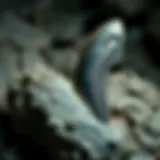The Importance of Geology Museums in Public Education


Intro
Geology museums serve as treasure troves of knowledge, illuminating the marvels of Earth’s geological landscape and the intricate processes that shape it. For both enthusiasts and the casually curious, these institutions act as bridges between the past and the present, showcasing the planet’s natural history through curated exhibits and a wealth of information. These museums don’t just display rocks and fossils; they cultivate a deeper understanding of Earth's intricate systems and the importance of preserving them.
The evolution of geology museums has been influenced by advancements in scientific understanding and changing public perceptions of geology. In recent years, their roles have broadened significantly. Beyond just preservation and exhibition, these institutions now engage in research, community outreach, and even conservation efforts, protecting not only geological artifacts but also the environments from which they originate.
Interactive exhibits, educational programs, and community initiatives are increasingly becoming the norm, transforming how we engage with geological sciences. It is this interactive approach that remains crucial in getting people invested in understanding our planet.
Featured Collectible of the Month
Overview
This month, we delve into the fascinating world of Ammonites, an extinct group of marine mollusks that showcase an array of sizes, shapes, and colors. Their spiral shells, often beautifully preserved, have made them a staple in geology collections and a favorite among rock hounds.
Fossilized ammonites date back to the time of the dinosaurs, making them not just collectibles but pieces of Earth's rich timeline. For collectors, finding and acquiring unique ammonite specimens can be an adventurous journey. Whether it's for aesthetic appeal or scientific interest, these fossils hold a special place in the hearts of many.
Historical Significance
Ammonites existed for over 300 million years, thriving during the Mesozoic era. Their shells exhibit a range of intricate patterns and can help geologists understand the marine environments where they once lived. Collecting and studying these fossils provide insights into prehistoric ecosystems and the evolutionary processes that have shaped life.
Collectors often appreciate the story behind each specimen, linking it to specific geological periods or locations. Their appeal lies not only in their beauty but also in the knowledge they provide about ancient life forms and the conditions they experienced.
"Collecting fossils is like piecing together a grand jigsaw puzzle of Earth’s history. Each new find brings us closer to understanding the whole picture."
Identification Techniques
Visual Characteristics
Identifying ammonite fossils can be a thrilling endeavor. Enthusiasts often look for specific characteristics:
- Shell Shape: Ranging from tightly coiled to intricately patterned, the shell’s form can indicate its age and origin.
- Coloration: The hues of fossils can vary widely, depending on the minerals present in the sediment where they were buried.
- Suture Patterns: These intricate lines can tell a lot about the specific genus and its clustering.
Individual fossil specimens can showcase different traits that help in identification as well as contribute to their overall value in collections.
Resources for Identification
For those keen on identifying their finds, several resources can aid in the process:
- Field Guides: Books dedicated to fossil identification can be an excellent reference.
- Online Forums: Websites like reddit.com host communities of fossil collectors eager to share knowledge.
- Museums and Local Clubs: Many offer workshops and expert sessions on identification techniques.
The dynamic and evolving realm of geology museums continues to enrich public understanding, creating an engaging space where science meets curiosity. As we continue to explore, the role and impact these institutions hold are more vital than ever.
Prologue to Geology Museums
In today’s fast-paced world, where understanding our planet’s past can often seem distant, geology museums serve as invaluable gateways to the Earth’s history. They are more than just repositories of rocks and minerals; they provide critical insights into dynamic processes that have shaped our surroundings over millennia. Through engaging exhibits and educational programs, these institutions help demystify complex geological concepts, making them accessible to everyone from enthusiasts to casual visitors.
Defining Geology Museums
So what exactly are geology museums? At their core, these centers are dedicated to showcasing the variety of the Earth’s geological features and processes. They bring to life the narratives of our planet, offering well-curated displays of fossils, mineral specimens, and geological maps. Such museums often house collections that span centuries, allowing visitors to trace a path from ancient geological eras to the contemporary landscape.
Key features may include:
- Educational exhibits demonstrating volcanic activity, erosion, and rock formation.
- Interactive displays where people can touch rocks or see simulations of seismic waves.
- Special collections showcasing unique specimens, like meteorites or rare gemstones.
By nurturing curiosity and offering tangible connections to the past, geology museums are important bridges between knowledge and fascination regarding natural history.
The Importance of Geology in Education
Education about geology is indispensable in shaping our understanding of the world. Life on Earth is intricately linked with geological processes: from the minerals that enrich our soils to the oil that fuels our cities and the natural disasters that remind us of our planet's dynamism. Knowledge of geology not only enriches individual understanding but nurtures environmental awareness and responsibility.
Some notable benefits include:
- Fostering Critical Thinking: Analyzing geological processes encourages a scientific mindset—growing skills that go beyond classroom walls.
- Promoting Sustainable Practices: Discussions surrounding mineral extraction and land use can lead to more environmentally sound decisions.
- Engaging the Community: Museums often collaborate with schools, enhancing outreach programs and fostering broader public interest in geology.
In essence, geology serves as a lens through which we can better understand not only our planet but also our responsibilities to it. It shapes our interactions with the environment and informs essential decisions that affect future generations.
"The history of the Earth is recorded in its rocks, and the story is far greater than mere collections—it's an ongoing narrative that connects us all."
Through unique educational avenues, geology museums empower individuals, allowing a deeper appreciation and respect for the intricate systems at play in our world.
Historical Development
Understanding the historical development of geology museums provides invaluable insight into their role today. These institutions are not just places of display; they represent the evolution of human curiosity and the quest for knowledge about the Earth. By unpacking their origins and key milestones, we can appreciate the broader context of geological study and the importance of these museums in shaping community understanding of our planet's past and ongoing processes.
Origins of Geology Museums
The roots of geology museums can be traced back to the Renaissance, a period rife with inquiry and discovery. Individuals began to collect fossils, minerals, and other natural specimens, driven by a fascination with the Earth's materials. At this time, collections were often found in private homes of wealthy merchants and scholars, serving primarily as personal displays of prestige. Over time, these curiosities piqued the interest of the broader public.
The first formal geology museum is recognized as the Ashmolean Museum, established at the University of Oxford in 1683. This museum was a pioneering effort to categorize and display rocks and minerals systematically. Still, it wasn't until the late 18th and early 19th centuries that geology museums began flourishing, coinciding with the advent of geology as a scientific discipline. Public interest soared when naturalists and geologists published their findings, and people craved to see the artifacts and specimens that fuelled these discoveries.
As cities grew during the industrial revolution, so did the need for educational resources. Cities like Paris and London began establishing institutions that could serve not only as repositories of knowledge but also as training grounds for budding geologists. Such environments fostered understanding and contributed significantly to the conservation and study of geological specimens.
Key Milestones in Museum Evolution
Several key milestones mark the evolution of geology museums.
- The Birth of Scientific Approaches: In the 19th century, the establishment of geological societies in various countries led to more formalized scientific approaches to collection and curation. Collections began to be curated based on strict scientific guidelines, allowing for better preservation and understanding of the specimens.
- The Role of Universites: During this time, universities began to establish their geology departments, which significantly advanced geological research. Museums aligned with these institutions enhanced their collections, showcasing not just specimens but also the scientific narratives behind them.
- Public Engagement Initiatives: In the 20th century, as accessibility to education increased, museums began to engage the public, incorporating educational programs, guides, and interactive displays. This shift transformed how audiences interacted with geology, making it approachable and relatable.
- Digital Transformation: The late 20th and early 21st centuries marked a significant shift with the introduction of technology. Virtual tours and online resources made geology more accessible to a broader audience, breaking barriers related to geography and socioeconomic status.
"Historical developments shape not only collections but also how we perceive our surroundings, linking past geology to the future world we inhabit."
Today, geology museums stand as a culmination of rich histories and evolving practices, blending science and public education. They allow visitors—from the most dedicated rock hounds to casual observers—to engage with the Earth's geological narrative in profound ways.
Curation and Exhibits
Curation and exhibits in geology museums are the backbone of these institutions, serving not only as display means but also as educational tools. The curation process involves a rigorous selection of specimens that tell a compelling story about Earth's history, evolution, and the dynamic processes that shape our planet. Exhibits are meticulously designed to engage and inform a diverse audience, bridging the gap between scientific knowledge and the general public's curiosity. The thoughtful curation of displays allows institutions to highlight natural phenomena like plate tectonics, volcanism, and erosion, providing a rich, immersive experience for visitors.
Types of Exhibits in Geology Museums
Geology museums showcase a broad range of exhibit types to cater to various interests and learning styles. Here are a few distinct categories that stand out:
- Static Displays: These are traditional showcases featuring mineral specimens, fossils, and rocks. They often include detailed descriptions that guide visitors through geological time.
- Interactive Exhibits: Engaging visitors in hands-on learning, these exhibits may allow pressing buttons, pulling levers, or using digital interfaces to explore geological concepts. For instance, a touchable volumetric display of tectonic plate movements makes complex ideas more tangible.
- Thematic Exhibits: Often focusing on specific topics such as paleontology or mineralogy, these exhibits are curated to deepen knowledge in those areas, employing storytelling techniques that illustrate the relationship between different geological phenomena.
- Temporary/Special Exhibits: These are periodically changed and often feature traveling collections or highlight current research projects. This keeps the museum experience fresh and aligns with ongoing scientific discussions.
Each exhibit type serves a purpose, whether it is to inspire awe, educate, or entertain. It's vital in these exhibitions to emphasize context, showing how individual specimens contribute to broader geological narratives.
Collections Management Practices
Effective collections management is the unsung hero of any geology museum, ensuring that specimens are not only preserved but also accessible for future generations. Museums employ various practices that fall under this umbrella:
- Documentation: This is where every item is meticulously cataloged, including its origin, scientific significance, and condition. Such records ensure that vital information is retained.
- Conservation Techniques: Specimens often require specific treatments to prevent degradation. This may include controlling the environment in which they are stored, such as humidity levels and light exposure.
- Accessibility Initiatives: Many museums are investing in digital catalogs that allow online access to their collections, making it possible for enthusiasts and researchers alike to engage with geology resources from afar. This aligns closely with contemporary expectations for transparency and accessibility.
- Loan and Exchange Programs: Collaborating with other institutions enhances diversity in collections and allows species to be studied by a wider audience. By lending or acquiring specimens, museums keep their exhibits dynamic and their educational value high, reinforcing ties within the geological community.
"The meticulous care of specimens is not merely an act of preservation but rather an investment in education and outreach for future generations."
Educational Outreach
The importance of educational outreach in the realm of geology museums cannot be overstated. These museums serve as pivotal platforms for imparting knowledge about Earth sciences, engaging not only avid enthusiasts but also those who may be less familiar with geological concepts. By crafting environments where learning can be both enlightening and enjoyable, geology museums play a significant role in nurturing a collective understanding of our planet’s processes, history, and the materials it offers.
Educational outreach encompasses a variety of programs and initiatives designed to bridge the knowledge gap between experts and the general public. This fosters a sense of community around geology and promotes informed citizenship regarding environmental matters.
Workshops and Seminars
Workshops and seminars represent a focal point for connecting visitors with geology in a hands-on way. These programs often attract school groups, families, and even adults eager to deepen their understanding. Let’s delve into a couple of key benefits:
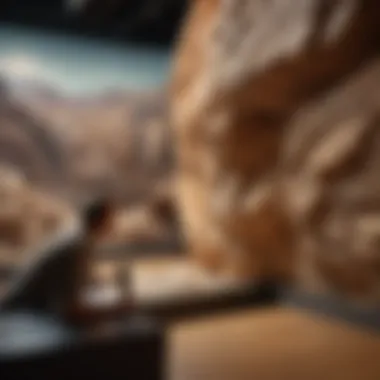
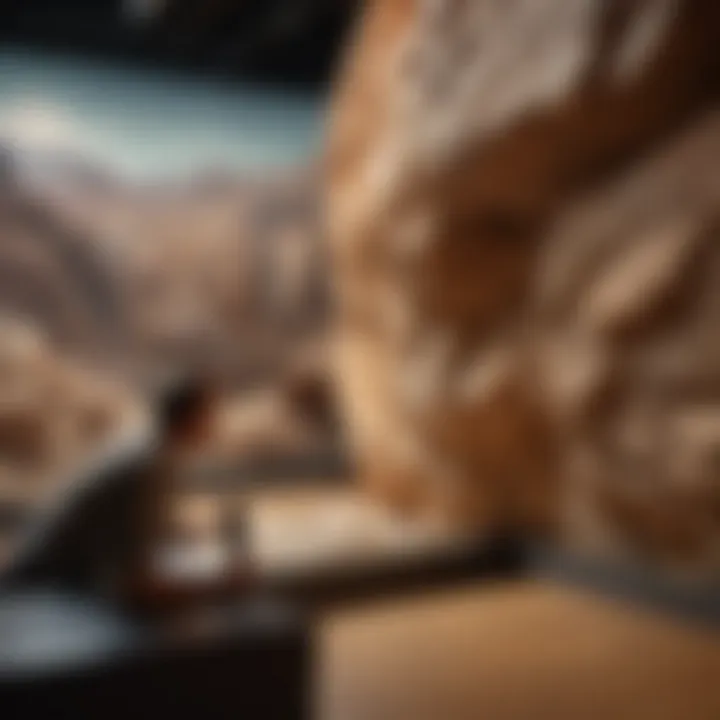
- Experiential Learning: Unlike traditional classroom settings, workshops offer participatory experiences. For example, a hands-on mineral identification workshop involving the actual specimens encourages engagement and retention of information by providing tactile learning opportunities.
- Expert Interaction: Engaging with professionals in the field can demystify complex subjects. When participants can ask questions directly, their understanding often deepens considerably as they receive firsthand knowledge from those practicing geology.
Furthermore, these workshops often include a variety of formats:
- Guest lectures from renowned geologists,
- Demonstrations of geological processes, and
- Field trips to local geological sites, helping attendees visualize concepts discussed in the museum itself.
Interactive Learning Tools
In this digital age, museums are increasingly harnessing the power of interactive learning tools to enhance visitor experience. Several strategies can contribute to making geology both accessible and intriguing:
- Augmented Reality (AR): Some museums utilize AR apps that allow users to visualize ancient geological events or interactively explore rock formations that are otherwise difficult to comprehend.
- Touchscreen Displays: Galleries that feature touchscreen exhibits provide a wealth of information at a visitor's fingertips. Viewers can explore data at their own pace, retrieving content like videos or additional facts about specific rocks, minerals, or geological phenomena.
- Online Resources: Furthermore, some museums extend their reach through comprehensive online portals that provide educational materials. Visitors may engage in virtual tours or access extensive databases of geological collections that pique their interest.
Interactive tools cater to diverse learning styles and promote self-directed exploration, which often leads to greater engagement.
Educational outreach programs cultivate not just knowledge but also passion, igniting an interest in geology that can resonate beyond museum walls.
In summary, the educational outreach endeavors of geology museums act as vehicles for understanding, advocacy, and engagement, connecting various demographics with the rich world of Earth sciences. They transform museums into dynamic learning centers, ensuring that geology is not just a field to study but something that captivates the mind and imagination.
Impact on Research
Geology museums serve as living laboratories and knowledge hubs that bolster geological research in various ways. Their influence extends far beyond the glass cases holding fossils and minerals; they act as catalysts for inquiry and exploration. Research in geology isn’t just about collecting data; it's about making connections and discovering new phenomena. Here, we delve into two vital aspects of how geology museums impact research: the support they offer for geological studies and the partnerships they form with academic institutions.
Support for Geological Research
Geology museums are often at the forefront of supporting field research initiatives. They provide essential resources such as collections, databases, and infrastructures that researchers rely on. The very artifacts on display—whether they are rare meteorites, fossils, or rock samples—are often the results of meticulous fieldwork. These collections not only serve educational purposes but also support ongoing research projects.
Moreover, many museums run dedicated programs aimed at funding and facilitating research. For instance, by housing valuable geological specimens, museums give scientists access to materials that might be scarce or located in remote regions. This access is crucial because it allows for cross-comparison, resulting in a deeper understanding of geological events across different time periods and geographical locations.
Some advantages include:
- Preservation of Original Specimens: Museums ensure that unique samples fully available for research without risks of degradation.
- Public Access to Research Findings: Muesums often publish their findings and exhibit their research outcomes to enhance public engagement and knowledge.
- Cross-Disciplinary Collaborations: Often, findings in one area of geology could resonate in another, sparking new avenues for study.
"Geology museums play a pivotal role in ensuring that knowledge is not only preserved but also propagated effectively, enabling researchers to build upon the past and foster innovative inquiries."
Collaboration with Academia
The partnership between geology museums and academic institutions is often symbiotic. Many museums collaborate directly with universities and other research facilities to carry out joint projects. This collaboration can take various forms: joint exhibitions, research papers, or co-hosted educational events. By blending the resources of museums—like well-maintained collections and exhibition space—with the expertise and innovative ideas of academia, a more dynamic environment for geological research is cultivated.
This cooperation also facilitates the training of future geologists. Internships and volunteer positions in museums provide students with practical experiences that classrooms alone cannot offer. They learn firsthand about collection management, exhibit design, and outreach programs. Moreover, students often spearhead research initiatives themselves, leading to fresh insights and innovative projects that can enhance the museum's offerings while also giving students valuable experience.
The benefits of collaboration can include:
- Enhanced Research Opportunities: Students gain access to geological specimens and datasets that would otherwise be unavailable for undergraduate research projects.
- Networking: These partnerships often foster networks of professionals, enabling face-to-face opportunities for cooperation and dialogue among experts.
- Community Engagement: Academic and museum collaborations often lead to enriched public programming, bringing geological science closer to the community.
In summary, the impact that geology museums have on scientific research—especially through support and collaboration—is vast and multifaceted. Their enduring influence on academia and the broader geological community continues to unfold, contributing significantly to our dynamic understanding of Earth’s history.
Community Engagement
Community engagement forms the backbone of geology museums, acting as a bridge between these institutions and the people they serve. It embodies the active interaction and collaboration between museums and local communities, fostering a collective sense of responsibility towards geological education and conservation. When museums prioritize engagement, they not only become repositories of knowledge but also vibrant hubs for societal interaction and sharing of ideas. Such connections enhance the relevance of these museums and promote a deeper understanding of geological sciences among the public.
Connecting with Local Communities
Establishing ties with local communities is fundamental for geology museums aiming to fulfill their educational and conservation missions. This connection encourages awareness about local geological resources and issues, enabling residents to appreciate the uniqueness of their surroundings. Museums can organize community events, guided tours, or family days that celebrate geological features specific to the area. Such gatherings help residents identify with their natural landscape, fostering stewardship.
For instance, a museum located near unique rock formations might arrange excursions to those sites, coupling them with informative sessions about their formation processes. By bringing the community into the dialogue, museums can address local geological concerns, such as erosion or land use, while also creating a platform for the exchange of knowledge.
- Benefits of Community Connection:
- Enhances educational outreach
- Promotes local stewardship
- Fosters a sense of ownership and pride
- Builds long-lasting relationships between the museum and the community
Moreover, involving local experts or hobbyists in events, such as rock identification days, enriches the museum experience. This not only validates local knowledge but also strengthens communal ties within the geology enthusiast circles.
Volunteer and Internship Opportunities
The role of volunteers and interns at geology museums cannot be overstated. These individuals contribute their time and energy, often bringing fresh perspectives that can invigorate museum programs. Providing opportunities for volunteerism and internships allows museums to extend their reach into diverse demographics. Volunteers often feel a sense of purpose, while interns gain invaluable real-world experience that they can carry into their future careers.
Through these opportunities, museums can tap into the skills and passions of individuals eager to dive into the world of geology. Programs can range from assisting in exhibit curation to organizing educational workshops.
- Types of Involvement:
- Exhibit Assistance: Help in setting up or providing tours of current exhibits.
- Educational Support: Assisting in workshops or demonstrations, making learning more interactive for visitors.
- Research Contributions: Interns can aid in geological research projects, contributing to actual scientific inquiry.
Beyond fulfilling immediate operational needs, these programs also foster a sustainable network of geology enthusiasts. They create pathways for mentorship, where seasoned professionals guide newcomers, ensuring the continuity of knowledge and practices in the field.
"Building community connections and offering hands-on opportunities can ignite a passion for geology that lasts a lifetime."
In a world where the challenges of geological preservation and education are paramount, the role of community engagement at geology museums serves as a powerful catalyst for change, empowerment, and appreciation of our planet's treasures.
Conservation Efforts
Conservation is a cornerstone of the mission that geology museums serve. These institutions are not just repositories of the Earth’s past; they play a crucial role in preserving geological heritage and promoting awareness about conservation practices. The mention of conservation forces us to reckon with the reality that our natural world is under consistent threat. Be it climate change, pollution, or the encroachment of urban development—geological features and the assemblage of fossils are increasingly endangered. Therefore, geology museums adopt a dutiful stance. They not only serve to educate the public but also actively engage in initiatives aimed at safeguarding our planet's geological treasures for future generations.
Role in Geological Conservation
One of the principal roles that geology museums undertake is the active participation in geological conservation efforts. They do so by allocating resources to research and development pertaining to geodiversity. This may include:
- Researching & Documenting: Many museums sponsor field studies that enable scientists to document geological formations. By understanding these formations, they can identify threats and help preserve them.
- Fostering Partnerships: Collaborations with universities and environmental groups present a synergy that enhances conservation efforts. This teamwork often results in policies advocating for geological preservation, which are essential for maintaining biodiversity.
- Community Involvement: Museums frequently engage local communities in conservation projects, aiming to educate them about the significance of their local geological features. This grassroots approach tends to yield better outcomes as locals develop a vested interest in their surroundings.
Through these efforts, geology museums not only play a pivotal role but often becom part of a larger dialogue regarding environmental care.
Exhibits Highlighting Conservation Issues
An important avenue through which geology museums promote conservation is via their exhibits. These displays are crafted not only to inform but to provoke thought and inspire action. The contemporary exhibits highlight various issues that are pressing in the geological community. Some notable themes include:
- Climate Change Impact: Exhibitions that illustrate changes in landscapes due to climate change empower visitors to comprehend the urgency of conservation. The stark visual contrasts between historical and current geological formations often resonate deeply.
- Endangered Fossils: Showcasing fossils that are on the brink of extinction emphasizes the fragile nature of geological history. When visitors realize that certain fossils may soon be lost forever, the sense of urgency to protect geological records matures.
- Sustainable Practices: Many museums display information regarding sustainable practices that can be adopted to reduce human impact on geological sites. This often includes methods such as eco-friendly tourism, which encourages responsible engagement with nature, ensuring preservation along the way.
"Every time we view a fossil, we aren't just looking at a remnant of the past. We're staring into a narrative—one that must be preserved for future generations."
In closing, the conservation efforts waged by geology museums drive home the idea that education and preservation are entwined destinies. As their exhibits shine a spotlight on the pressing issues of our day, they work hand-in-hand with the community to foster an awareness that extends well beyond their walls.
Geological Tours and Field Trips
Geological tours and field trips represent a vital aspect of the education and experiential learning that geology museums offer. They provide hands-on experiences that are indispensable for anyone looking to deepen their understanding of the Earth's geological features. Through these carefully structured outings, museums can bridge the gap between theory and practice. For rock and fossil collectors, these field trips serve not just as educational platforms but as opportunities to discover, collect, and appreciate geological resources in their natural contexts.
Organizing Educational Field Trips
When planning educational field trips, museums usually take great care to align the itinerary with both educational objectives and the interests of their participants. A well-organized field trip can take visitors to sites of geological importance, such as quarries, rock formations, or mineral deposits.
- Preparation is Key: Organizers need to evaluate the age and knowledge level of the group to tailor the experience appropriately.
- Choose Relevant Sites: Ideal locations often include areas rich in unique geological features, like the Grand Canyon or volcanic regions such as Mt. St. Helens.
- Expert Guidance: Having knowledgeable guides or geologists on hand can enhance the experience. They can bridge gaps in understanding and provide context to the natural marvels on display.
- Safety First: Implementing safety measures is non-negotiable to ensure that all participants can explore the natural environment without unnecessary risks.
- Post-Trip Assessment: Collecting feedback post-visit helps organizers refine future trips. This assessment can provide insights into what worked well and what could be improved.
Importance of Field Experience
Field experiences are indispensable for grasping the complexities of geological processes. This real-world engagement allows participants to witness first-hand the effects of weathering, erosion, and sedimentation in ways that textbooks cannot convey. Here’s why field experience matters:
- Experiential Learning: Nothing beats the knowledge gained from seeing geological formations in person. The tactile experience of handling rocks and fossils solidifies learning in a way that theory alone cannot.
- Connection to Nature: Field trips foster a deeper appreciation for natural surroundings, encouraging individuals to value conservation efforts when they observe Earth's beauty up close.
- Networking Opportunities: Participants often meet like-minded individuals. Such connections can lead to friendships or even collaborations in future collecting endeavors.
- Informed Collecting: For collectors particularly, understanding the geological history and context behind a specimen improves their collecting practices. It helps them discern the significance of various materials they may come across.
"Field trips open windows to the Earth's vast stories. Each rock, each layer captures moments in time. Exploring these stories cultivates a sense of responsibility towards Earth’s treasures."
In summary, geological tours and field trips not only enhance knowledge but also inspire a deeper connection to the environment. These programs serve rock and fossil collectors well, enriching their passion with professional insights and a sense of community.
Challenges Facing Geology Museums
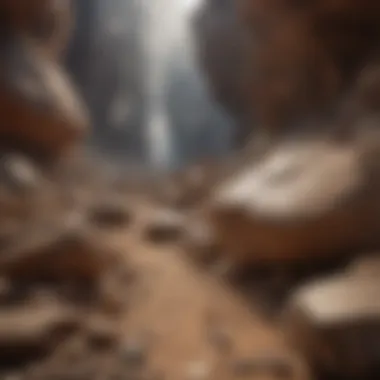

Geology museums play a crucial role in our understanding of the Earth and its processes. However, they are not without their challenges, which can significantly impact their operations and effectiveness. It is imperative to address these challenges to ensure that these institutions continue to educate, inspire, and engage visitors about the wonders of our planet. This section delves into two major hurdles that geology museums face: funding and budget constraints, and the need to adapt to technological changes.
Funding and Budget Constraints
Financial sustainability is a recurring worry for geology museums around the world. Many museums operate on tight budgets that may not cover all operational costs, thus limiting their ability to expand exhibits or improve facilities. Funding may come from grants, donations, or government support, yet these channels are often uncertain and subject to changes in economic conditions.
- Limited Resources: A museum with a scarcity of funding cannot hire specialized staff or invest in modern technology for displays and educational materials.
- Exhibit Quality: Without sufficient funds, the quality of exhibits suffers. An engaging display could be the difference between attracting a visitor or losing their interest.
- Public Programs: Museums often rely on educational programs to foster a passion for geology among the public, but lack of financial support makes it difficult to offer diverse activities.
In regions where geology is less popular or prioritized, museums might struggle even more. It becomes necessary for these institutions to innovate funding strategies, such as forming partnerships with educational institutions or applying for grants focused on cultural outreach. Without addressing these financial challenges, the future of many geology museums remains uncertain.
Technological Changes and Adaptation
In today's fast-paced digital world, adapting to technological advancements is not merely an option, but a necessity. Geology museums must embrace change to stay relevant and engaging. For instance, the integration of interactive displays, virtual reality experiences, and online resources can dramatically enhance a visitor's experience, helping them grasp complex geological phenomena.
- Keeping Up with Change: As technology evolves at a breakneck pace, museums must keep up. This includes regularly updating their exhibits to incorporate new findings and using emerging technology to keep the information fresh and engaging.
- Training Staff: The introduction of new technologies requires staff training. It’s essential for museum personnel to learn how to effectively utilize modern tools to enhance educational programs.
- Audience Expectations: Today’s visitors often come equipped with their own devices and a desire for interactive content. If a museum does not meet these expectations, they risk alienating a segment of potential visitors.
"Technological integration is paramount; it can either bolster or diminish the relevance of a geology museum in the eyes of a visitor."
Future Directions
The landscape of geology museums is constantly evolving, particularly in recent years with advancements in technology and shifts in visitor expectations. Understanding the importance of these future directions is vital for the sustainability and relevance of geology museums in today's complex world. Museums that embrace innovative approaches and engage with their audiences effectively position themselves not just as places of learning, but as dynamic hubs of community interaction and environmental stewardship.
Innovations in Exhibit Design
Exhibit design is no longer just about showcasing artifacts. It has transformed to become a multi-sensory experience that can captivate an audience at a much deeper level. Museums are beginning to use cutting-edge technology, such as augmented reality (AR) and virtual reality (VR), to create immersive environments where visitors can interact with geological processes as if they were experiencing them firsthand. For instance, imagine walking through a simulated volcano’s eruption or staring into the depths of the oceans as a marine geologist. These innovations make geology not just visible, but palpable.
Additionally, more effort is being put into designing exhibits that cater to a variety of learning styles. Interactive touchscreen displays, 3D models, and engaging storytelling techniques allow visitors from different backgrounds to connect with geology in ways that resonate with them personally. This method does not just help in attracting a diverse audience; it also promotes a deeper understanding of scientific concepts through personal engagement.
Key Elements of Innovations in Exhibit Design:
- Interactivity: Visitors want to touch, engage, and manipulate exhibits.
- Storytelling: Each exhibit should tell a story that captures the imagination of visitors.
- Technology Integration: Incorporate modern tools to provide an enriched educational experience.
Potential Growth Areas for Museums
Looking ahead, geology museums have several potential growth areas that can further broaden their impact. First, partnerships with local schools and universities can facilitate the development of specialized, curriculum-based programs. This not only brings in students but also fosters a love of geology in the younger generations. The more connections made with academic institutions, the better prepared museums will be to serve as educational extensions of these establishments.
Moreover, engaging in community outreach initiatives stands as another critical growth avenue. Museums can create programs that specifically target underrepresented groups in the geology field, thus addressing inclusivity and fostering a love for geoscience in diverse populations. By cultivating relationships with local environmental organizations and community centers, museums can extend their reach and provide educational resources that might otherwise be inaccessible.
"The future of our planet depends on how well we understand it. Geology museums play a crucial role in this educational framework."
Finally, the push for sustainability within museum practices is gaining momentum. Geological museums can lead by example, focusing on conservation ethics both within exhibit designs and general operations. By promoting sustainable practices, they not only enhance their credibility but also align with a growing public awareness about environmental issues.
As the field of geology continues to develop, so must the museums that represent it. Innovations in exhibit design and potential growth areas will shape how geology museums contribute to education and community involvement, ensuring that they remain vital in fostering knowledge about Earth's wonders and challenges.
Notable Geology Museums Around the World
Geology museums serve as vital repositories of knowledge and conservation, showcasing the intricate web of Earth’s history. They provide insight into the processes that shape our planet and emphasize the significance of geological research in understanding our natural environment. The museums highlighted in this section are not just buildings housing rocks and fossils; they are gateways to discovery, bringing to light the artistry of nature itself. Each museum uniquely contributes to public education, research, and the preservation of geological heritage, making them invaluable to enthusiasts and professionals alike.
Must-Visit Geology Museums in North America
North America boasts some of the most significant geology museums that attract visitors from all over the globe. Among these, the American Museum of Natural History in New York City stands out with its spectacular Hall of Minerals and Gems, where visitors can marvel at unique specimens like the Star of India sapphire and exquisite meteorites. This museum captures the imagination, making geology relatable through interactive displays.
In the same vein, the Smithsonian National Museum of Natural History offers a breath-taking panorama of Earth's geological processes, highlighted by the Hope Diamond. This museum goes beyond exhibitions, offering educational programs that cater to all ages, allowing participants to dig deeper into Earth sciences.
For those who are closer to the west coast, the California Academy of Sciences in San Francisco combines various scientific disciplines under one roof. Its Steinhart Aquarium and natural history exhibits create a holistic learning environment about Earth’s ecology, geology, and evolution.
- American Museum of Natural History
- Smithsonian National Museum of Natural History
- California Academy of Sciences
- Hall of Minerals and Gems
- Educational Programs
- Hope Diamond Exhibit
- Interactive Learning
- Multidisciplinary Science
- Interactive Education
Prominent International Museums
Globally, several geology museums have gained recognition for their contributions to education and research.
The Natural History Museum in London is a treasure trove, housing millions of specimens. Notably, its geology gallery features stunning displays of precious gems and minerals. The museum runs active initiatives to engage local schools and communities, promoting geology as an accessible field of study.
On the continental stage, the Royal Belgian Institute of Natural Sciences, located in Brussels, showcases an impressive collection that includes significant fossils like the Iguanodon skeleton. Their emphasis is on presenting the evolutionary perspective of geology, reinforcing the importance of fossils in understanding Earth's past.
Museo de Ciencias Naturales in Buenos Aires, Argentina features extensive geological exhibits. This museum highlights the richness of South American geology, emphasizing regional treasures like the Patagonian fossils, which tell stories of once-thriving ecosystems now fossilized in stone.
Here’s a concise look at these prominent international museums:
- Natural History Museum, London
- Royal Belgian Institute of Natural Sciences
- Museo de Ciencias Naturales, Buenos Aires
- Geology Gallery
- Community Engagement Programs
- Evolutionary Exhibits
- Significant Fossil Collection
- South American Geology
- Patagonian Fossils
These museums inspire fresh generations of geologists and earth scientists by immersing them in the wonders of geological phenomena, connecting the past with present-day practices and concerns.
The role of these notable geology museums extends beyond mere conservation. They encourage exploration, promote scientific inquiry, and cultivate a culture of appreciation for the Earth and its processes. Such institutions not only benefit the visitors but also contribute significantly to the field of geology through ongoing research, fostering a deeper understanding of our planet's history and dynamic systems.
Visitor Experience
Visitor experience serves as the heartbeat of geology museums, where every facet, from the moment one steps through the door to the time they leave, determines how well the institution connects with its attendees. It goes beyond just displaying rocks or fossils; it's about creating an environment that inspires curiosity, engagement, and a lasting appreciation for Earth’s geological wonders.
A well-crafted visitor experience incorporates multiple elements:
- Atmosphere: The museum's layout, lighting, and sound can evoke a specific feeling. A thoughtful design invites exploration and ignites interest.
- Interactive Exhibits: Touch screens, hands-on displays, and immersive activities help visitors to actively participate instead of remaining passive observers.
- Guided Tours: Providing knowledgeable guides to lead visitors through the exhibits can enhance understanding. Guides can share stories that help to connect visitors emotionally with the history of the rocks and minerals around them.
- Educational Materials: Availability of brochures, multimedia presentations, or digital guides allows individuals to take deeper dives into topics that interest them.
The benefits of an engaging visitor experience are manifold. It not only enhances learning but helps to instill a sense of ownership and pride in local geological heritage. Visitors leave with knowledge, stories, and often a newfound enthusiasm about geology, which could transform casual interest into a lifelong passion.
Moreover, when visitors feel positively about their experience, they are more likely to spread the word, leading to organic promotion of the museum. It builds a community of enthusiasts who return or bring along friends and family, creating a cycle of engagement that is beneficial for both the museum and its audience.
Engaging the Audience
Engagement must be the core focus for any geology museum aiming to foster a love for Earth sciences. The underlying idea is to transform the exhibit experience from a static view to a dynamic interaction. One effective approach is utilizing modern technology, like augmented reality, to let attendees visualize geological processes, such as the formation of a mineral or the eruption of a volcano, right before their eyes.
Moreover, museums can design special events that focus on current geological survey topics or newly discovered fossils. Engaging talks from renowned geologists, live demonstrations, and hands-on workshops encourage visitor interaction and inquiry. Social media platforms like Facebook and Reddit also play a vital role in building hype around upcoming events, allowing museums to harness community interest beforehand.
A great way to actively engage visitors is through community-based initiatives, where locals can contribute stories or artifacts, creating a sense of belonging and respect for the museum's mission. This engagement is beneficial as it acknowledges the significance of community knowledge in geological narratives.
Feedback and Improvement Initiatives
To provide a keen experience, geology museums must stay attuned to visitor feedback. Capturing insights through surveys, comment cards, or informal chats can reveal areas that need tweaking and those that shine bright. Actively seeking opinions shows visitors they are valued and that their input can lead to real change.
Using digital platforms allows for easy collection of this feedback, and analyzing data trends helps to identify common themes. If many visitors note that certain displays were unclear, for example, that’s a signal to rethink exhibit layout or accompanying info panels.
Additionally, growth shouldn’t end with what the museum has on offer right now. Continuous improvement encourages museums to adapt to changing technology and visitor expectations, ensuring relevance in an increasingly digital world. Being responsive to needs and changes is what keeps the institution fresh and exciting.
“The visitor experience is not just about how many rocks and minerals we have; it’s about how we make those connections.”
In closing, a strong focus on visitor experience creates a vibrant community of geology enthusiasts who not only appreciate Earth's treasures but are also driven to spread their knowledge to others. The interweaving of engagement and feedback can pave the way for an enriching and dynamic museum landscape.
Technological Integrations
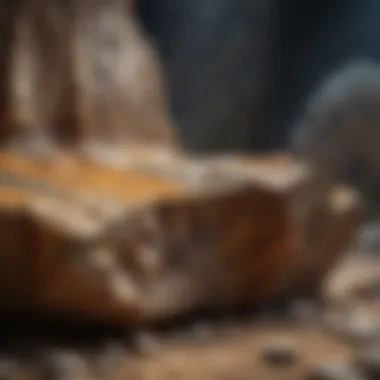
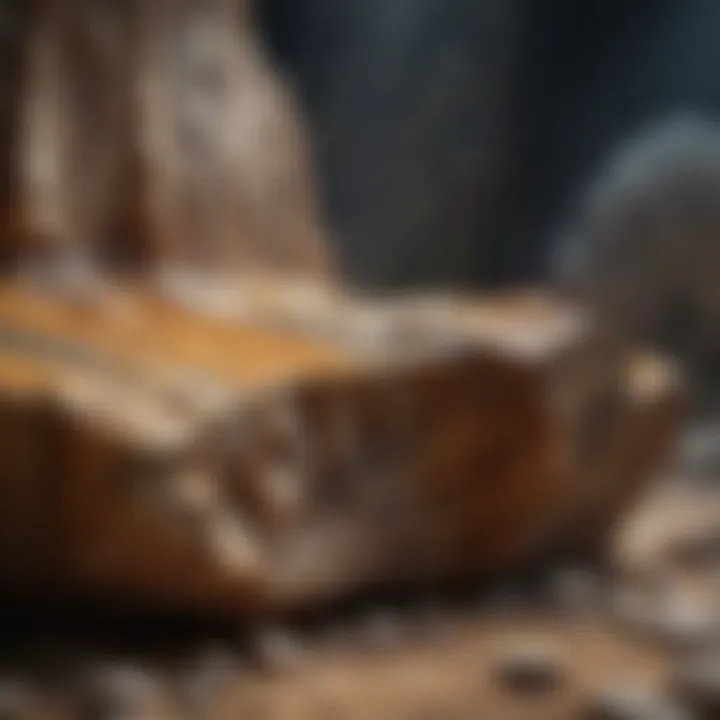
In the evolving landscape of geology museums, the role of technology is becoming more pronounced. For both enhancing the visitor experience and ensuring the effective dissemination of geological knowledge, technological integrations represent a pivotal shift. These innovations are not just about keeping up with trends; they fundamentally change how museums engage audiences, deliver content, and facilitate educational experiences. The benefits are manifold, but this integration also brings its own set of considerations that must be carefully navigated.
Virtual Tours and Online Resources
Virtual tours have become a cornerstone of modern museum experiences. Beyond just mimicking a traditional museum visit, they offer unique ways to explore vast geological landscapes right from the comfort of one's home. For instance, an aspiring rock collector, who might live far from notable geology museums, can now "walk" through exhibitions featuring everything from stunning mineral specimens to intricate fossil displays.
These virtual platforms utilize high-definition images, interactive elements, and audio commentary, making the learning process more engaging. Moreover, online resources often include curated educational materials like videos, articles, and interactive quizzes, allowing visitors to delve deeper into specific topics at their own pace.
Some key advantages of virtual tours include:
- Accessibility: Breaking geographical barriers enables wider access to knowledge.
- Flexibility: Users can schedule their exploration at times that suit them best.
- Inclusivity: Individuals with mobility challenges can experience exhibits that may otherwise be difficult to access.
However, virtual offerings should not entirely replace physical visits. The tactile experience of handling rocks and fossils, for instance, is irreplaceable. Virtual tours should complement, rather than substitute, traditional museum experiences.
"The blend of technology with geology invites not just our eyes but also our imagination to explore the wonders of Earth like never before."
Mobile Applications for Enhanced Learning
Mobile applications have rapidly gained ground as valuable tools in enhancing the visitor experience at geology museums. These apps are designed to make information more accessible and engaging, catering to a wide audience from seasoned collectors to interested novices. Through gamification strategies, quizzes, and immersive augmented reality features, these applications effectively aim to enhance the educational landscape.
Key features of these apps often include:
- Interactive Maps: These offer a guide to museum exhibits, allowing users to navigate smoothly through displays.
- Augmented Reality Elements: By pointing a mobile device at a display, users can access extra information, like animations showing geological processes.
- Personalized Learning: Users can select topics of interest, curating their educational journey based on personal preferences.
On another note, the deployment of an app poses challenges, such as ensuring user-friendliness and keeping content updated with the latest information in geology. Ultimately, these apps strive to create an immersive learning environment, forging deeper connections between visitors and the geological materials housed in the museum.
The way geology museums embrace technology not only enriches visitor experiences but also aligns with modern educational approaches, ensuring that learning remains interactive and participatory. In the age of information, these institutions can illuminate the wonders of the Earth for audiences everywhere.
The Role of Social Media
Social media has burrowed deep into the fabric of daily life, transcending traditional communication and reshaping how we connect with the world around us. For geology museums, these platforms are not just a megaphone for announcements; they are pivotal tools that drive engagement, education, and community. The role social media plays in promoting these institutions cannot be understated. It offers a unique avenue for geology museums to broaden their reach and foster connections between diverse audiences and the geological sciences.
Promoting Geology Museums Online
In the digital age, the presence of geology museums on platforms like Facebook, Instagram, and Twitter can significantly boost visibility. These channels allow museums to showcase their collections, announcements, and events in vibrant ways. For instance, a well-captured image of a splendid fossil may ignite curiosity among viewers and draw them closer to the museum's offerings.
Consider some effective strategies that geology museums can employ:
- Visual Storytelling: High-quality photos and videos are eyecatchers. Whether it's a time-lapse of an exhibit setup or spotlighting intriguing specimens, visuals can paint a compelling narrative.
- Live Interactions: Hosting live Q&A sessions or virtual tours can engage audiences who may not physically visit the museum. This fosters a sense of accessibility and inclusivity.
- User-generated Content: Encouraging visitors to share their museum experiences creates a community feel. People appreciate seeing their posts featured on official accounts.
By utilizing these strategies, geology museums can build a robust online presence while piquing the interest of rock and fossil enthusiasts alike.
Creating Community through Digital Platforms
The importance of community in fostering a love for geology speaks volumes. Social media serves as a bridge, connecting individuals with interests in the field. These platforms enable geology museums to cultivate a sense of belonging, encouraging interactions that transcend geographical barriers. Here's how:
- Interest-based Groups: Creating or participating in Facebook groups dedicated to geology can create discussions that enrich visitors’ understanding and appreciation of the sciences.
- Engagement through Hashtags: Using relevant hashtags helps get the word out about specific events, topics, or even fun facts about geological phenomena. This keeps the conversation flowing.
- Collaboration with Influencers: Collaborating with social media influencers in the geological or educational space can enhance credibility and reach, introducing the museum to new audiences.
"To some, geology might seem like just 'rocks and dirt,' but social media can change that perception by turning the focus onto stories that connect those rocks to our everyday lives."
In tailoring these community-building efforts, geology museums not only find a means to engage but also position themselves as relevant players in the conversation about Earth's treasures and processes.
Diversity and Inclusion
In today’s interconnected world, the principles surrounding diversity and inclusion hold more significance than ever, especially within the context of geology museums. These institutions are not just repositories of rocks and fossils; they serve a broader purpose of educating a wide audience about Earth’s processes and resources. Embracing diversity and inclusion can amplify the impact of geology museums, making them more relevant and accessible.
When museums actively promote inclusivity, they ultimately enrich the visitor experience. An inclusive environment welcomes individuals from various backgrounds, providing them with equal opportunities to explore and learn. This is not only valuable for the visitors but also fosters a sense of community, boosting engagement and participation.
Moreover, employing diverse staff who bring unique perspectives can enhance the quality of the exhibits and programs. A varied team is likely to generate fresh ideas, creating more relatable content that resonates with a broader audience. For example, incorporating narratives related to indigenous peoples’ interactions with geology not only acknowledges their contributions but also establishes a bridge to modern science.
Fostering Inclusivity in Geology
To foster inclusivity in geology museums, institutions need to develop programs that are culturally sensitive and relevant. This means designing exhibits that highlight the geological contributions from various cultures and communities.
- Community Involvement: Museums should seek collaboration with local groups. Holding community events can provide insights into cultural geologies unique to the area and foster a bond between the museum and the community.
- Tailored Programs: Crafting educational programs suited for diverse audiences can greatly improve participation rates. Language accessibility, for instance, ensures that non-native speakers can engage and learn effectively.
- Regular Training: Staff training on diversity and inclusion is crucial. It equips them with the skills necessary to create and maintain a welcoming environment for everyone.
Ultimately, inclusivity enriches the educational experiences provided by geology museums and contributes positively to community dynamics.
Engaging Diverse Audiences
Engaging a diverse audience is a complex yet rewarding undertaking for geology museums. It requires innovative strategies and a commitment to understanding visitors' varied interests and needs.
- Interactive Engagement: Designing hands-on learning experiences can draw in groups that might otherwise feel alienated. This includes workshops, family days, or volunteer opportunities that invite participation from all sectors of the community.
- Outreach Programs: Consistent outreach, especially in underrepresented areas, can stimulate interest in geology. Collaborating with schools and community centers can spark curiosity in young minds, paving the way for future rockhounds.
- Social Media Presence: An active social media presence helps in reaching out to diverse communities. Platforms like Facebook and Reddit can be used to share engaging content that reflects varied cultural perspectives, while promoting events aimed at inclusivity.
"Engagement with diverse voices in geology can lead to a broader understanding and appreciation of Earth’s rich history."
The success of rock and fossil collectors often hinges on the stories and history behind each specimen. Museums that engage diverse audiences increase opportunities for people to connect and share their own geological stories, making the narrative richer.
Case Studies of Effective Museum Programs
Exploring case studies of effective museum programs sheds light on the practical applications of theory in real-world settings. These case studies serve as a vital part of the narrative, offering insights into what works well in engaging the public, especially in regard to geology and natural history. By delving into these exemplary models, we can uncover specific elements that make programs successful and the benefits that arise from them.
One of the key aspects in these studies is the theme of exhibits. Thematic exhibitions allow museums to tell a story through carefully curated rocks, fossils, and accompanying artifacts. For instance, the Royal Tyrrell Museum in Canada often features dynamic themes, like "Dinosaur Provincial Park," which immerses visitors in Canada's rich paleontological past. This approach doesn't just display objects; it creates a narrative that captures the imagination of both enthusiasts and casual hikers.
"Successful museums curate narratives that resonate with visitors, making the experience richer and more memorable."
Another essential factor highlighted in these case studies is interactive learning and engagement strategies. Programs that encourage hands-on interaction not only cater to diverse learning styles but also build a connection between the visitor and the subject matter. Museums such as the Carnegie Museum of Natural History exemplify this by integrating technology in their exhibits. Digital touchscreens allow guests to explore detailed geographic data and fossil formation processes.
Moreover, analyzing community-centric programs reveals how museums can act as a bridge between scientific knowledge and public awareness. For example, the California Academy of Sciences in San Francisco engages local audiences through community workshops aimed at fostering local geology appreciation. These programs not only serve a practical educational purpose but also cultivate a sense of belonging and ownership among participants.
Successful Exhibit Themes
Successful exhibit themes often incorporate both art and science, reflecting the museum’s dedication to transforming the visitor experience. By blending artistic expression with geological knowledge, themes invite the audience to appreciate the beauty of Earth’s structures and processes.
- "The Art of Rock" Exhibit: This kind of themed exhibit typically showcases how geological formations inspired local artists, blending geology with creativity.
- "Under the Sea" Exhibit: Focusing on marine geology, this theme dives into underwater ecosystems and the geological processes beneath the ocean bed.
- "Volcanoes Alive!" A thematic approach that encapsulates the fury and wonder of active volcanoes, often enhanced with multimedia elements like videos and simulations.
These themes allow museums to connect on deeper emotional levels with their audiences, fostering a more profound appreciation for Earth's complexities.
Community-Centric Programs
Community-centric programs form the backbone of many successful geology museums, aiming not only to educate but also to empower local communities. These initiatives are designed to foster a sense of stewardship over natural resources and enhance the public's connection to their geological heritage.
Some notable community-centric programs include:
- Local Rock Collectors’ Days: Events where enthusiasts gather to showcase their collections, share knowledge, and engage with experts.
- Youth Scholarship Programs: Offering scholarships for students pursuing geology-related studies fosters interest among younger generations.
- Citizen Science Projects: Involving locals in actual data collection for geological surveys helps build hands-on experience and instills pride in participant contributions.
Programs designed with the community in mind reflect a museum’s responsiveness to the needs and interests of those it serves. By doing so, these institutions not only educate but also inspire future generations to explore and protect Earth’s geological wonders.
Closure
The exploration of geology museums brings us to a crucial understanding of their role in society and science. These institutions are not merely collections of rocks and fossils; they serve as dynamic platforms for education, research, and community engagement. At their core, geology museums are pivotal in translating complex geological concepts into accessible narratives for the public. They illuminate the Earth's history, connecting visitors to the processes that shape our planet. This connection can foster a sense of stewardship towards our environment, urging individuals to appreciate and protect geological resources.
Summary of Key Points
The findings presented in the article highlight several essential points about geology museums:
- Educational Impact: Geology museums contribute significantly to public education, providing resources and experiences that engage people of all ages.
- Research Collaboration: They assist in advancing geological research by hosting collections that serve academic and scientific communities.
- Community Involvement: The museums connect with local communities, enhancing their relevance and fostering inclusivity.
- Innovative Outreach: The integration of technology, like virtual tours and interactive exhibits, expands their reach beyond physical confines.
As more individuals become curious about Earth's geological wonders, museums play an essential role in this journey of discovery.
The Future of Geology Museums
Looking ahead, the future of geology museums seems both promising and challenging. They are at a crossroads, where the shift towards digital experiences and interactive learning can either enhance visitor engagement or pose technological hurdles. To thrive in the coming years, geology museums must consider several aspects:
- Embracing Technology: Leveraging advancements in technology, such as augmented reality or smart apps, can offer visitors immersive experiences that enhance their understanding of geological concepts.
- Sustainable Practices: Many museums aiming to highlight conservation efforts are also integrating sustainable practices into their operations. This not only educates visitors about eco-friendly measures but also sets a standard for other institutions.
- Diverse Programming: Ensuring diverse programs that cater to a range of audiences, from seasoned collectors to schoolchildren, will help bridge gaps in knowledge and encourage broader participation.
- Collaboration and Networking: Establishing more partnerships with universities, research organizations, and local communities will allow for sharing resources and knowledge, thus strengthening their outreach.
In summary, geology museums must navigate these changes with a keen eye. By adapting to new trends while remaining true to their educational mission, they can continue to play an invaluable role in public understanding and appreciation of our planet's geological heritage.
